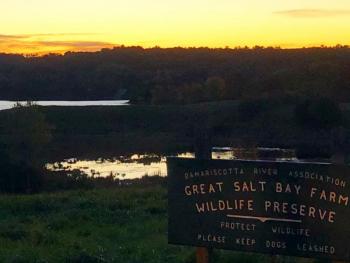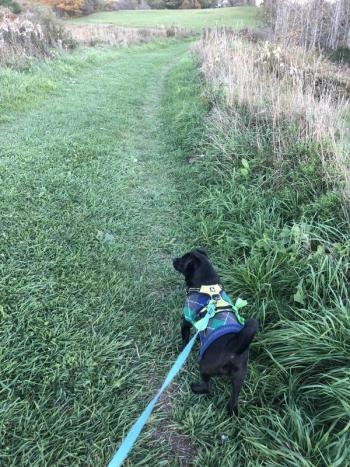Mystery Sparrow on a Coastal Fall Hike
On one of last weekend’s glorious days, we had the pleasure of taking a late-day stroll through the fields and around the pond at the Salt Bay Farm Preserve in Damariscotta. This has been one of our favorite places for many years. We used to take our toddler, now a college student, here for walks because of the easy and safe trails and beautiful panorama of the bay and surrounding landscape. As an elementary schooler, our boy attended the famed Camp Mummichog day camp here with one of his lifelong buddies. And through the years after that we continued to visit regularly. One of the highlights when he and his friends were younger was to explore the Native American Village down near the bay.
The day we visited was a classic Maine fall day. The sharp, late-afternoon light made the orange and yellows of the trees seem to glow. Dozens of juncos flashed their white tail edges as they flew up from the trail. Yellow-rumped warblers gave their low “chuck” calls as they flushed from the alders. Mallards and black ducks floated on the pond. Our little black dog (carefully on a leash at all times as is the rule there) reveled in exploring the scents of this new (for him) place.
As the light began to wain and we reached the far corner just above the pond, we noticed a small, round sparrow jump up from its hiding spot in the thick grass and zip away. We knew right away it was something different, especially when we glimpsed some orangey color somewhere on it as we tried to follow it for a split second with the binoculars. One of us (Jeff—Allison stayed with the doggy) traipsed out into the grass to see if we could get a decent look at the mystery bird. After two more glances as it flushed, flew a few dozen yards and dove again into the thick grass, it seemed like the bird would have to remain a mystery. But after regrouping down the trail we decided to walk back to the area where we had first seen it.
We could not believe our luck when, just as we arrived, a sparrow flew up into a clump of low bushes and provided some stunning binocular views (at least for the one of us who wasn’t responsible for the doggy). The bright orangey color was on the eye-stripe, face and upper breast of a Nelson’s sparrow.
Nelson’s sparrows are a specialty bird of Maine because they breed in coastal salt marshes from Maine north through the Maritimes to the shores of the St. Lawrence. In these coastal saltmarshes, they are at great future risk from the ravages of climate change-caused sea level rise. But Nelson’s sparrows have a wonderfully mysterious distribution: another subspecies inhabits freshwater marshes from the Northwest Territories of Canada south and east to Minnesota; and a third subspecies is found along the shores of Hudson and James Bay from Manitoba through Ontario to Quebec.
It’s hard to know if the bird we flushed from the field at the Salt Bay Preserve was a bird of our resident subspecies or from one of the interior breeding subspecies. The brightness of our bird and some other features made us wonder if it could have been from one of those faraway places—we like to imagine it especially as one that might have spent the summer along Hudson or James Bay. A quick perusal of eBird showed several other brightly colored Nelson’s sparrows spotted in the mid-coast area of Maine over the last two weeks. Perhaps there was a little pulse of inland Nelson’s sparrow migrants coming through. But it is hard to say because there is still so little known about the movements of those northern Canada breeding populations of this elusive species.
What a wonderful mystery to close a delightful fall walk on the coast of Maine.
Jeffrey V. Wells, Ph.D., is a Fellow of the Cornell Lab of Ornithology and Vice President of Boreal Conservation for National Audubon. Dr. Wells is one of the nation's leading bird experts and conservation biologists and author of the “Birder’s Conservation Handbook.” His grandfather, the late John Chase, was a columnist for the Boothbay Register for many years. Allison Childs Wells, formerly of the Cornell Lab of Ornithology, is a senior director at the Natural Resources Council of Maine, a nonprofit membership organization working statewide to protect the nature of Maine. Both are widely published natural history writers and are the authors of the popular books, “Maine’s Favorite Birds” (Tilbury House) and “Birds of Aruba, Bonaire, and Curaçao: A Site and Field Guide,” (Cornell University Press).


_(22224365600).jpg)






























